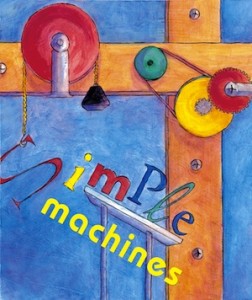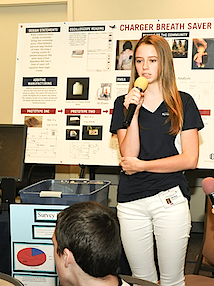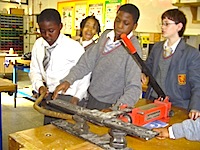Engineer a Great Middle School STEM Curriculum
A MiddleWeb Blog
 What does a good middle school STEM curriculum look like? We’re hearing this question more and more often as schools across the U.S. and elsewhere get serious about establishing STEM learning experiences for their students in the middle grades.
What does a good middle school STEM curriculum look like? We’re hearing this question more and more often as schools across the U.S. and elsewhere get serious about establishing STEM learning experiences for their students in the middle grades.
My answer: there’s no single, die-cut curriculum that every school should be using. There’s plenty of opportunity for hand-crafting an effective teaching and learning design as teachers and school leaders deepen their discussion about “what we want our STEM program to look like and accomplish.”
I imagine this deeper discussion might include these probing questions:
• Are you looking for an integrated, interdisciplinary curriculum involving science, technology, engineering, and mathematics?
• Do you want STEM curriculum to involve students in tackling real-world issues through exploration, inquiry, and problem-solving experiences?
• Can you identify or develop a curriculum that regularly requires critical thinking, creativity, effective collaboration, research skills, and communication?
To be sure, that sounds like an ambitious agenda for any curriculum. All of these ingredients won’t be in the mix during every moment of every lesson. But over the course of their middle school journey, you probably want each cohort of middle school students to experience and master STEM learning at the ambitious levels these questions suggest.
Here are 8 things you may want to consider in choosing and/or crafting a successful STEM curriculum. My list is not exhaustive but it addresses the major elements of programs that have been praised for their quality and effectiveness.
1. Is engineering the driving force behind our STEM problem-solving?

If you are considering a curriculum package, look carefully at the power train. Is the engineering design process (EDP) at the heart of the problem-solving approach? The curriculum should involve students and teachers in using this process throughout the STEM challenge – from clearly identifying the problem to creating and developing solutions.
2. Will our students gain a deep understanding of the content areas?

3. Do our students work to solve real-world problems?
Does the curriculum lead kids to apply problem solving, engineering design, and subject area content to address real social, economic, and environmental situations in their local and extended communities? Throughout their middle school years, students should learn how to ask and investigate questions about the world they experience through daily living.
4. Are our instructional approaches engaging?

Kids should have plenty of opportunity to muck about, make decisions, and test their ideas as possible solutions. Multiple right answers are possible as students work to solve a problem. The classroom environment is risk-free, and mistakes and design failures are treated as good methods of learning.
5. Does our curriculum address ways of successfully engaging students in teamwork?
Students work in teams to solve STEM challenges. This brings one of the most needed life skills into the curriculum, and develops synergy needed for problem-solving. The curriculum must provide guidance for teachers to help students learn and practice successful team behaviors and personal interaction skills.
6. Is technology used appropriately in addressing our STEM challenges?
Ideally you would have technology available that you need for advanced computer applications, such as structural design, and students would be comfortable using this technology. At the middle level that seldom happens. However, STEM curriculum will likely offer suggestions for math and science apps that students can use with their STEM work, and the Internet can give them quick access to information as they research. Technology should be presented as more than computers; technology includes all tools used to make life easier and better. The curriculum will likely acknowledge that students actually create technologies as they create products to address real-world problems.
7. Are our students taught communication skills?

As students go through the middle years, STEM coursework should help them learn and value productive communication at personal, team and public levels. (Photo, US Army RDECOM)
8. Does our curriculum include authentic assessment?
Since a big focus of STEM education is inquiry-based learning and the ability to problem-solve, students need to be tested in practical ways that evaluate the complexity of STEM learning. What does success look like in this curriculum? Are students learning more than just basic content? Look for curriculum that suggests ways to assess changes in creativity, student attitudes, student participation, the classroom environment, teamwork skills, communication skills, and so on.
STEM assessments should include periodic checks to see if diverse groups of students are experiencing success. Are all students playing a role in the successful completion of the challenge? If you want STEM classrooms that are creative, risk-oriented and progressive, assessments should collect information about those areas.
The cure for what ails us

A great STEM curriculum, taught by teachers who know how to engage kids and “guide on the side,” will not only produce more young scientists in the future, it will serve as a true antidote for the most dreaded middle school malady: Boredom.



































I would love a recommendation of a lessons or project-based book for integrating good STEM based learning into all the middle sciences: physical, life, and earth science. I teach all three and have found it fairly easy to do STEM type lessons in my physical science, but the other sciences are still lacking. Any suggestions?
This is an excellent overview of the STEM concept. I’ve seen far too many presentations trying to “teach” teachers about STEM using lessons that have no engineering component. Without engineering and the tools of technology, it’s not STEM.
Crystal, I’ve found writing curriculum for life sciences to be more challenging than physical or earth science. However, with the help of some teachers in the Mobile County School System, we’ve developed some STEM lessons that you might find interesting. Disclaimer! Not all of them include all of the STEM components – these had to match exactly with their district course of study in science and math. (Check out both the math and the science STEM ideas.) Go to http://bit.ly/1jyQjCc and open the 6th, 7th, and 8th grade folders. You’ll find lessons, slides, and handouts.
On another note, I don’t know of a single project based book. However, type in the Design Squad and check out some of their lessons. You can type “STEM lessons” in a search engine and a lot will come up. Just remember – not everything that purports to be STEM is truly STEM.
Thanks!
Anne,
Do you know of any districts that have decided not to use a text book and instead wrote their own curriculum using free on-line resources?
Thanks for your affirmation, Bill. I certainly agree . . . the engineering science, and technology as kids apply the content to create products that solve problems. Glad you commented!
Looks like I lost a whole phrase in my first comment to you, Bill. Here it is again!
Thanks for your affirmation, Bill. I certainly agree . . . the engineering is the heartbeat of the STEM process – the intersection of science, and technology as kids apply the content to create products that solve problems. Glad you commented!
Anne, Do you have any suggestion for tools that students can use to create and test prototypes? It would be great if every school and every student could afford to build real, working prototypes, but that is often not an option. Do you know of any virtual prototype apps or websites that will allow groups with limited funds and resources the chance of developing and testing as part of the engineering design process? Thanks!
Hi, Matt – I’ve used tools as simple as straws, wire mesh, washers, string, guttering, tape, clay, PVC pipe, etc. for kids to construct working prototypes. (I didn’t use all of those in the same project.) Our understanding of prototypes is that these are not the “real thing,” but are models of the real thing. Engineers generally use more sophisticated materials when constructing prototypes, but the prototypes kids construct can serve the same purpose.
Generally, because of limited funding, schools cannot afford to construct scale models using “real” materials; or the materials may be dangerous for student use – particularly if they involve certain chemicals. So we make do with cheaper substitutes. Nevertheless, students can learn important math, engineering, science, and technology concepts they need.
Still – you’ve brought up a question that I am interested in pursuing. I think I’ll do some research on that – sounds like good information for a blog post. If you come up with any ideas, feel free to share them!
I am referring your question on virtual prototype apps or websites to my tech guru colleague, Emily Vickery. Stay tuned!
Anne
This is a wonderful comment, on point and illuminating. Thank you!
Matt – here’s Emily’s answer:
My first question regarding prototyping is what is the objective, or project? Would need more info here, I believe, to possibly find other resources.
For example, the BrainPop Roller Coaster might be a good app if students can manipulate variables to prototype their virtual train/roller coaster.
Also: Wolfram – interact with applets using variables to test design theory – http://education.wolfram.com/physics/mechanics/
Tinkerbox – kids interact with puzzles and create machines.
Quoted below is from the following website –
http://www.graphite.org/app/tinkerbox –
Price: Free, Free
Grades: 6-12
Platforms: iPad, iPhone, iPod Touch
“They can also create their own inventions using the objects — balls, bolts, chains, connectors, conveyor belts, fans, wheels, ropes, scissors, switches, wenches, and more. The app comes preloaded with several inventions, and kids can alter those inventions or study them for inspiration.
TinkerBox is an impressive tool for kids interested in engineering. Either option — the puzzles or the inventions — alone is worth an investment, and TinkerBox includes both. The physics of the higher levels get quite challenging, incorporating space gravity. The number of objects available for building is impressive, too. Kids are empowered to create the machines they want and can choose which objects will create the outcome they desire. They can also learn a bit of history about each tool as they learn how to effectively use it in the Elements Help section.”
I hope these resources help.
Thanks! It’s possible that something like Tinkerbox would be helpful. Essentially, this is for a web-based STEM competition called eCYBERMISSION (http://www.ecybermission.com). Student are asked to use science or engineering to find a solution to a community-based problem. I work on the competition and I’d like to try to level the playing field for students and schools that do not have as much money or resources as others. I constantly see projects submitted with something to like “We didn’t test our prototype because we couldn’t actually build it so we don’t have any results.” I have found that many students are very excited when it comes to brainstorming, but once they realize they can’t even build a working a prototype to test, they lose interest. So, I want to come up with a way that will allow all students the chance to do this. My first thought was to go virtual since that would lower the cost, thus my question.
I will take a look at the ones listed above. But if you think of any other ideas, I’m all ears!
Thanks again!
Anne — I am finding this quite interesting. I teach at a K-12 school where I am chair of the math dept. for 7-12. We have an incoming 5th grader who is quite advanced in our lower school who is going to be learning our enriched pre-algebra curriculum as a tutorial this year. However, he is so bright and it is one-on-one that they will certainly run out of that curriculum about 2/3 of the way into the year. So I am trying to put together some (or just one big) authentic STEM or STEAM experiences for him to work on with his tutor. I have no experience with this, though, nor does his tutor, but she is willing to facilitate anything. What do you suggest? One thought after doing some research is to find an invention contest, but I haven’t found a local one yet. And we would need a fair amount of guidance for this. Alternately, there could be some long-term project connecting him to the community. But again, I would need some direction. I am really glad I happened on this website, as you sound like a really good source of information. Thanks in advance.
Wow, Dina, I’m late to this post! Sorry I didn’t go back and check it sooner. I imagine by now you’ve settled on some sort of program for your prodigy. If not, I’d suggest coming up with some sort of real-world problem. Design Squad Nation http://pbskids.org/designsquad/ can give plenty of good ideas for problems, and they also give some “how to” steps to help solve the problems. I’d start there. You might find some more help here: http://www.middleweb.com/5003/real-world-stem-problems/ I really like the idea of finding a STEM community problem that he can work with in conjunction with real engineers and scientists.
Once you identify a problem, teach a systematic way of working through a problem to find a hands-on solution for it. This site can give some information for how to teach a STEM lesson, so some of the tips may apply. http://www.middleweb.com/4328/12-steps-to-great-stem-lessons/
Those are starter steps. Again – I apologize for missing your post and hope that these suggestions are timely enough to be of some help.
Thanks!
Hi Anne, I am finishing my PhD in Public Health but my passion is to educate middle school students about laboratory medicine as a career path (I have 28 years in the field) and my challenge has been getting my Capstone approved with the reason being “this is more of an education issue than a public health issue’ but with the avg age of med techs being 53, this IS a public health crisis as we will not have enough trained workers to run very sophisticated machines and IT products. I am going to try again (my mentor doesn’t want me to change my project) and incorporate use of STEM principles. Thoughts??
You are on the right track, Debbie. This is exactly what business and industry are saying – not enough STEM educated graduates to fill positions in fields such as public health. Research shows that the introduction of STEM principles and ideas must begin in elementary school followed by a strong middle school focus so that kids can make the right choices for coursework in high school and college. Inadequately educated and trained Public Health workers constitute a crisis. And the lack of med techs is a real crisis. And if our education system doesn’t prepare enough students to fill these jobs, then how will the work get done? Who will design, innovate, solve problems that arise, and collaborate effectively? You are certainly going in the right direction with your focus on education – which is the
foundation for the Public Health industry.